For a taste of a wild and untamed version of Southeast Asia, Sumatra certainly takes some beating. Jungle treks, volcano hikes, stunning scenery and family-friendly activities all lie in wait. You’re heading somewhere unlike anywhere else in the region, so read on for our Sumatra with kids travel guide and get ready for an adventure.
There aren’t many places in the world quite like Sumatra. With top-notch environmental experiences on offer, including epic overnight jungle treks and hiking to the brim of a volcanic crater, you’d expect the place to be overrun with tourists. And while it’s by no means a hidden gem, and the peak season of July and August does get busy, for the rest of the year you often feel like you have the place to yourself.
So if you’re on the lookout for a wild, challenging and rewarding family holiday, where a sense of achievement and wonder are almost guaranteed, Sumatra is ready and waiting. We visited for a week and felt like we’d had a year’s worth of experiences. It’s already one of our favourite places in Southeast Asia, and we hope you get inspired to book a trip and see it for yourself.
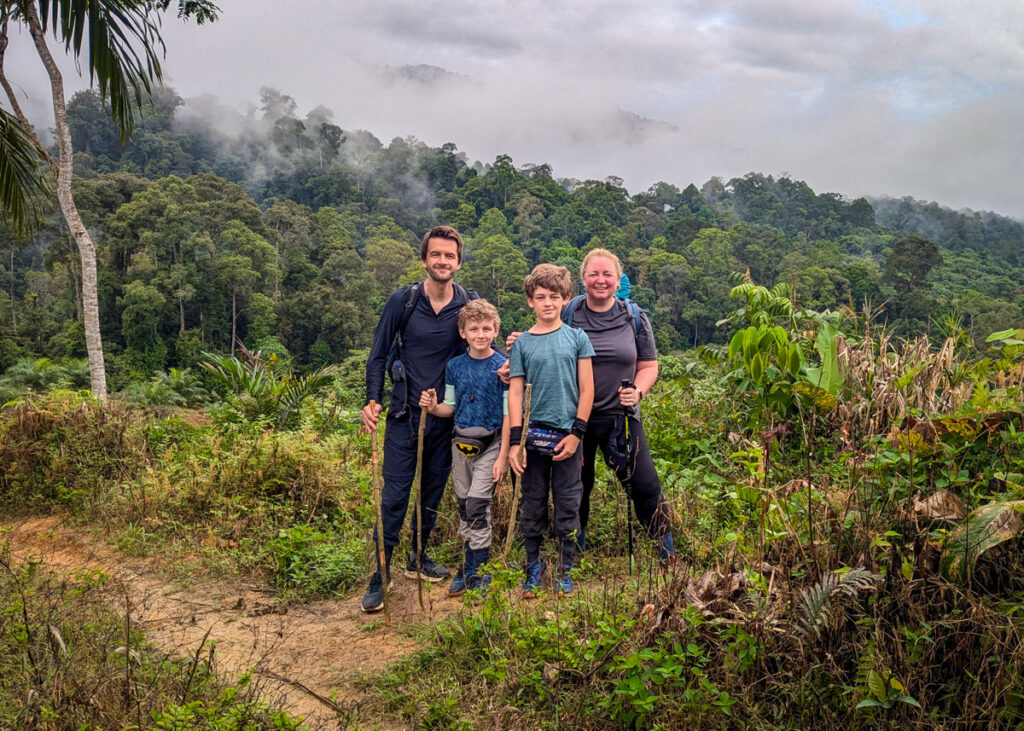
Disclaimer: This post contains affiliate links. If you click to purchase, it is at no additional cost to you, and I receive a small commission.
Is Sumatra safe to travel with children?
Yes, Sumatra is a safe place to visit with children and there are no particular concerns you should have before or during your visit. Indonesia in general, with Lombok and Bali in particular, does occasionally get a bad press in terms of safety, but many of these incidences are the result of late nights and drinking, both of which are unlikely to affect you in Sumatra, travelling as a family.
Road conditions are poor though in Sumatra, ranging from not too bad to atrocious. The standard of driving is actually quite skilful, it’s just they attempt more tight overtaking manoeuvres than you might enjoy. All the vehicles we travelled in had seatbelts and were in excellent condition, but you won’t find any child car seats. If you’re here with younger children, you could consider bringing your own from back home but consider how much of a hassle it’ll be when you’re not using it.
As long as you’re up-to-date with your immunisations and have adequate travel insurance, your trip here is likely to be safe and successful. This is the travel insurance that we recommend.
The Sumatran people are kind, gentle and friendly, and give children a huge amount of affection and hospitality. In some of the non-tourist places on the island, including Medan, it’s fairly unusual to see other travelling families, so your kids may get extra attention from inquisitive locals. This is harmless, but some kids might not love being the centre of attention.
On the jungle treks, it’s essential you use a guide (it’s pretty much mandatory in any case), and they will help to keep kids safe on the trek, including applying tobacco water to ward off leeches and pointing out any treacherous sections. As long as your kids have a reasonable level of fitness, and are used to hiking for several hours at a time, they won’t find the treks or hikes overly challenging.


How to get around Sumatra with kids
The handy e-hailing app, Grab, is great for getting taxis around Medan. We also used it to prebook a taxi to the airport on our final morning, which was especially useful for our early departure.
However, outside of Medan, Grab is not widely available. We attempted to book a ride in Berastagi, but despite the app functioning, there were no cars available. Instead, we relied on local minivan buses to get around (our accommodation host explained the bus system to us).
For travelling between major destinations on our Sumatra itinerary with kids below, we recommend arranging private car transfers. The cost of four bus tickets is often comparable, and on the winding road up to Berastagi, having the option to ask your driver to pull over for a break can be a huge relief.
Private car transfers can be arranged through your accommodation, which is exactly what we did.
Visas and other arrival forms for Indonesia
Citizens of the UK, USA, Australia, NZ, and the EU will need a visa for Indonesia (citizens of ASEAN countries are generally exempt for visits up to 30 days). While you can get a visa on arrival, we noticed that there was only one desk at the airport in Medan for this option.
We recommend keeping travel life easy and arranging your visa online before your arrival to Indonesia (click here to visit the official eVisa website for Indonesia). This is very easy, and a 30-day visa confirmation will be emailed to you to show to the immigration officer on arrival (you do not need to print this out, it is fine to show this on your phone).
The cost of this visa is Rp500,000 and it can be extended for an additional 30 days should you wish.
You will also be required to complete customs forms and health forms. There are screens to do this at immigration, but again, it makes travel life easier if you complete these beforehand.
Indonesia Electronic Customs Declaration (e-CD)
All travellers must fill out an Indonesia e-CD form prior to departure, even if you are not carrying any restricted items. Click here to complete the form. Once approved, the completed form will be sent to you via email. Please have it ready to show customs officials upon arrival.
SATUSEHAT Health Pass
All travellers must fill out the SATUSEHAT Health Pass and present the QR Code to the health officials upon arrival in Indonesia (although no one actually asked to see ours). Click here to complete the form.
Immunisations for Sumatra
It’s essential you speak with a medical professional before travelling to Sumatra to check which vaccinations and anti-malarials you may need.
In the UK, the excellent Fit For Travel website from the NHS has all the information you’ll need. Make sure you plan ahead for any vaccinations as some require a longer course of injections over a few weeks.
The majority of Sumatra is considered ‘low to no risk’ for malaria so, unless you’re in a high-risk group, antimalarials aren’t required, but please check yourself. Fit For Travel has another excellent map to check the current situation.
Tips for travelling Sumatra with kids
- Allow for long travel days due to poor road conditions and don’t cram too much into your time in Sumatra
- There is a lot of hiking involved and your kids need to be used to hiking.
- Dress conservatively. Sumatra is a very different island to Bali.
- Pack a pair of long trousers and a long-sleeved top to protect yourself from mosquitoes in the jungle. Click here to check out our full packing list for the jungle trek.
- Use mosquito repellent with DEET in the jungle (we use Jungle Formula). You can pick up mosquito repellent in Bukit Lawang, but it doesn’t contain DEET.
- Pack a poncho or light rain jacket. It will rain at some point. This is the tropics.
- Pack a jumper and jacket for climbing Mount Sibayak. It gets surprisingly chilly up there, and you’ll need a jumper in the evening in Berastagi.
- Pack head torches for every member of the family. You will not only need these on the jungle trek, but also for visiting the cave in Bukit Lawang.
- Leave the heavy hiking boots at home. Comfortable running trainers are absolutely fine for the hikes in Sumatra, including the jungle trek.
- Get cash out at the airport in Medan when you first arrive. There are no ATMs in Bukit Lawang and you will need to pay for everything with cash.
- Travel with backpacks, not suitcases. When you arrive to Bukit Lawang there is a 15 minute walk to the accommodation and rolling a suitcase along here would be a nightmare. These are the kids travel backpacks we recommend.

One week Sumatra with kids itinerary
This one week itinerary focuses on a small section in North Sumatra starting and ending in Medan, which we found to be perfectly paced for travelling with kids. If you have extra time, we’ve included a suggested itinerary extension below.
We used private transfers to travel between destinations (this was often the same price as 4x bus tickets), which was always arranged through our accommodation.
The two main activities you are going to want to experience in Sumatra with kids are:
Day 1: Medan to Bukit Lawang
Where we stayed: Green Hill Guest House (not on booking platforms, email direct to book). We booked into the treetop chalet, which has one double bed and bunk beds with 2 single mattresses. There’s a large balcony overlooking the rooftops of Bukit Lawang and across to the jungle on the opposite side of the river. It’s a stunning spot, and centrally located in the tourist area with lots of restaurant options.
With a morning flight arrival time, you can head straight over to Bukit Lawang rather than staying in Medan overnight (there is time at the end of this one week itinerary to explore Medan).
We arranged a private transfer (IDR 700,000) through Andrea at Green Hill to collect us straight from the airport and take us to Bukit Lawang. It’s a good idea to get cash out of the ATM at the airport as there are no ATMs in Bukit Lawang and cash is required for payment everywhere.
The journey to Bukit Lawang takes about 4 hours with a short stop for a bite to eat about 1.5 hours in. On arrival to Bukit Lawang you will be met by staff from Green Hill who will then escort you to your accommodation. This is about a 15 minute walk.
It’s been a long travel day, so head across the way to Wild River for dinner to enjoy your first taste of Sumatran food.
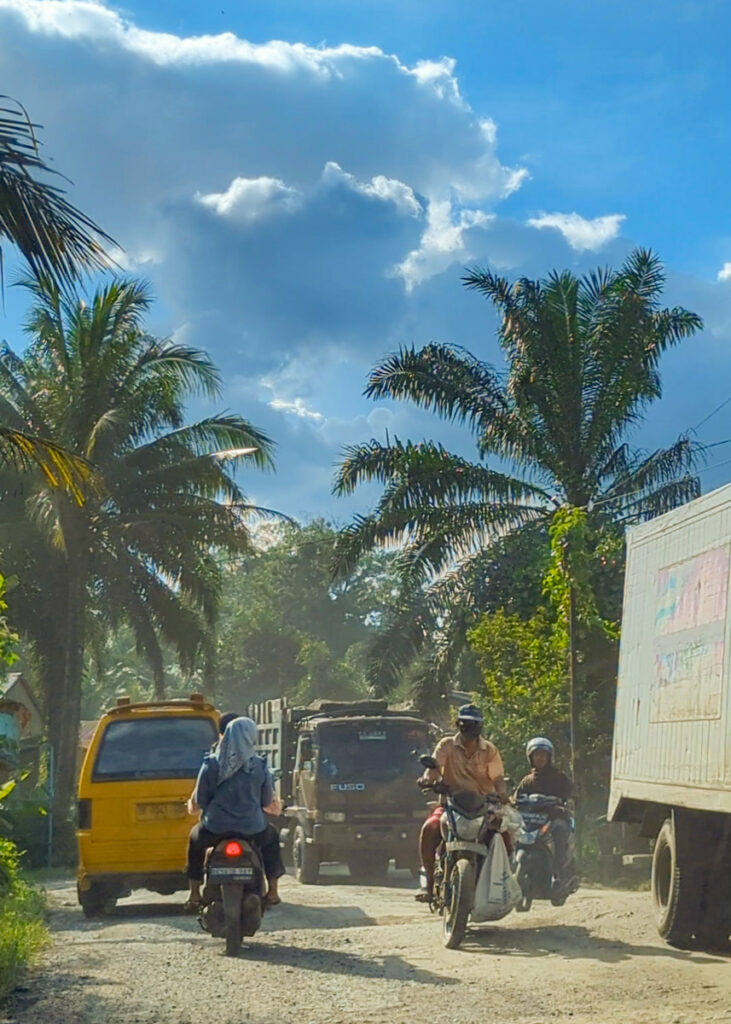
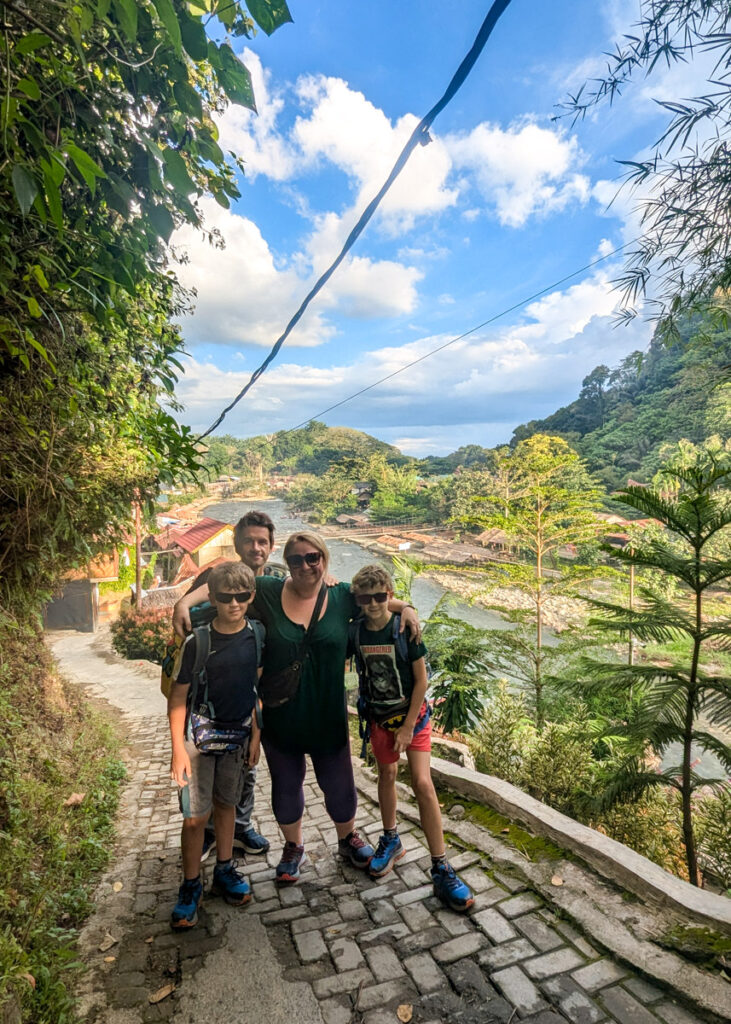

Day 2: Walk to Bat Cave, Bukit Lawang
Where we stayed: Green Hill Guest House (not on booking platforms, email direct to book)
Start your day with breakfast at Green Hill (not included in the room rate), where you can choose from a selection of oats, eggs, and pancakes. After fuelling up, set off on a walk to Bat Cave where, unsurprisingly, you’ll find plenty of bats!
The walk to the cave entrance takes about two hours, and no guide is needed. From Green Hill, turn left along the footpath and cross the second bridge over the river. From there, follow the well-marked signs to Bat Cave. It’s a flat and easy-going walk, with a good chance of spotting Thomas leaf monkeys, a species endemic to Sumatra.



Do take note of the way, as you will be returning along the same route and there are no signposts back to Bukit Lawang. There are a few tricky junctions that could easily be missed if you aren’t paying attention.
Just after walking through the rubber tree plantation you will reach a ramshackle hut and gate to Bat Cave. When we visited there were two chain-smoking, non-uninformed members of staff to take your money for tickets. While your gut may question the legitimacy of these staff members, this is indeed the official entrance, and for IDR 10,000 per person, we were handed four water-damaged, creased tickets. While a guide isn’t required, the staff may offer their services if you prefer one.
The walk to the actual cave is rather tricky. The footpath is steep and slippery, and require careful navigation of intertwined tree roots. But it’s a very short distance (about 100 metres) and then you arrive at the mouth of the cave.
Once inside, a head torch is essential as the cave is pitch black and requires scrambling over rocks. You can explore quite far in, but the strong smell of bat droppings may limit how long you stay!
Return to Green Hill via the same route. Once back at your accommodation, set aside some time to repack and prepare for your 2-day jungle trek!
Day 3: First day of jungle trek
READ: 2D/1N Bukit Lawang family jungle trek with Green Hill
Where we stayed: Jungle camp organised through Green Hill
The two day jungle trek arranged through Green Hill is one of the best family adventures we’ve had. It’s exhausting, it will push you out of your comfort zone, and you’ll sweat like never before, but it’s absolutely worth it.
This first day takes you through pristine jungle that is not accessible to other tourists. You really are venturing off the beaten track here, but with expert guides to lead the way and take care of you. Although, you do have to carry all your own gear (porters available at additional cost).

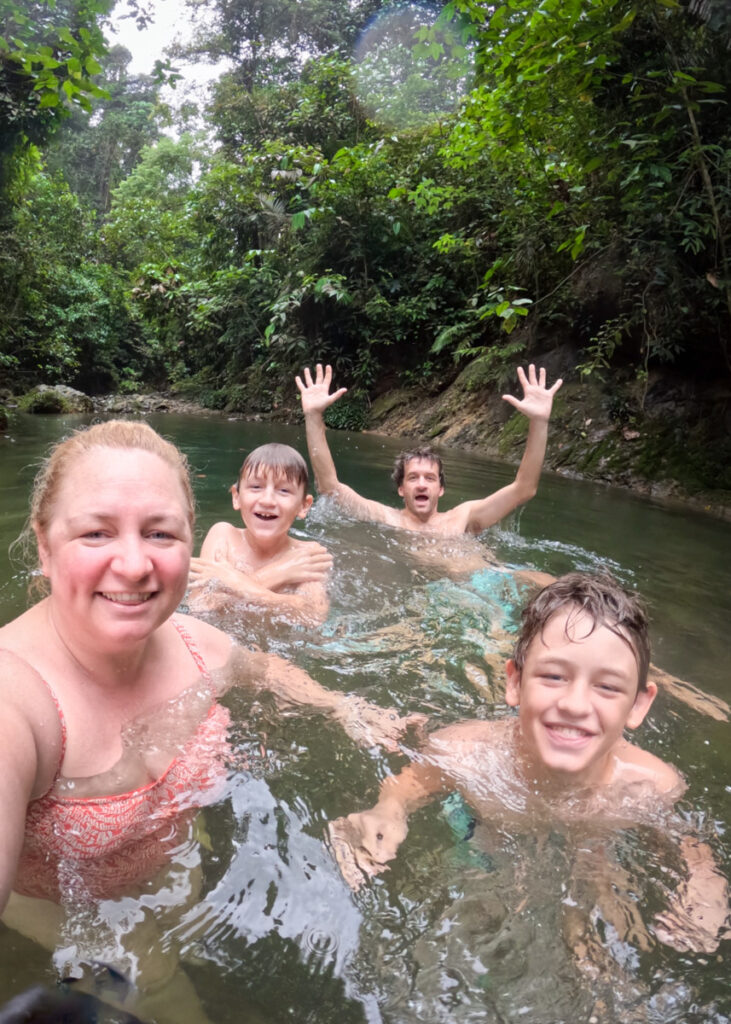

Starting from a local village your trek leads you downhill to wade across a river. After putting your trainers back on, your guides will dab tobacco juice over your socks and trainers to deter the leeches (you will come across a lot of leeches).
It is then 3-4 hours of trekking uphill, downhill (never flat) through the jungle. Along the way, you’ll stop to observe interesting plants, insects, and jungle life, but primate sightings are rare in this part of the rainforest. The jungle here is so wild that the animals tend to shy away from humans. That said, being completely immersed in such raw, untouched wilderness with no-one else around except your family and guides is an incredible experience.
Lunch is prepared by your guides and enjoyed by the river, a well-earned break before continuing the trek to camp. The camp itself is incredibly rustic, with wood-frame huts covered by tarpaulin for shelter and privacy. You’ll be sleeping on a hard floor with only a thin mat for padding, so bringing a sleeping bag liner and a camping mattress is recommended for extra comfort. There are no toilets. If nature calls, you’ll be handed a stick to dig a hole in the jungle. Drinking water is collected from the river and boiled for safety.
Despite the basic setup, dinner is a feast, expertly prepared by the camp chef. And after hours of sweating through the jungle, a swim in the river is the perfect way to cool off before settling in for the night. It really is a wonderful setting.
Day 4: Second day of jungle trek
READ: 2D/1N Bukit Lawang family jungle trek with Green Hill
Where we stayed: Green Hill Guest House (not on booking platforms, email direct to book)
After what might be the most uncomfortable night’s sleep of your life, it’s time to leave your idyllic jungle camp and start the 45-minute uphill trek back to the main road.
Here, a jeep will be waiting to drive you back toward Bukit Lawang for the second section of your jungle trek. This part of the trail is more popular with tourists, but for good reason—the wildlife here is more accustomed to humans, meaning you’ll have a better chance of spotting orangutans.
We were lucky enough to see a mother orangutan with her baby, away from the crowds, gracefully moving through the jungle canopy.
This section of the trek is about 5km and as it is along more defined paths compared to yesterday, is easier going (although there are a few slippery, steep sections). With a stop for a fruit platter prepared by your guides, it takes about 3 hours.
At the end you reach a stony beach along the river where you can enjoy a swim and a bite to eat before the grand finale – riding a raft along the river back to Green Hill!


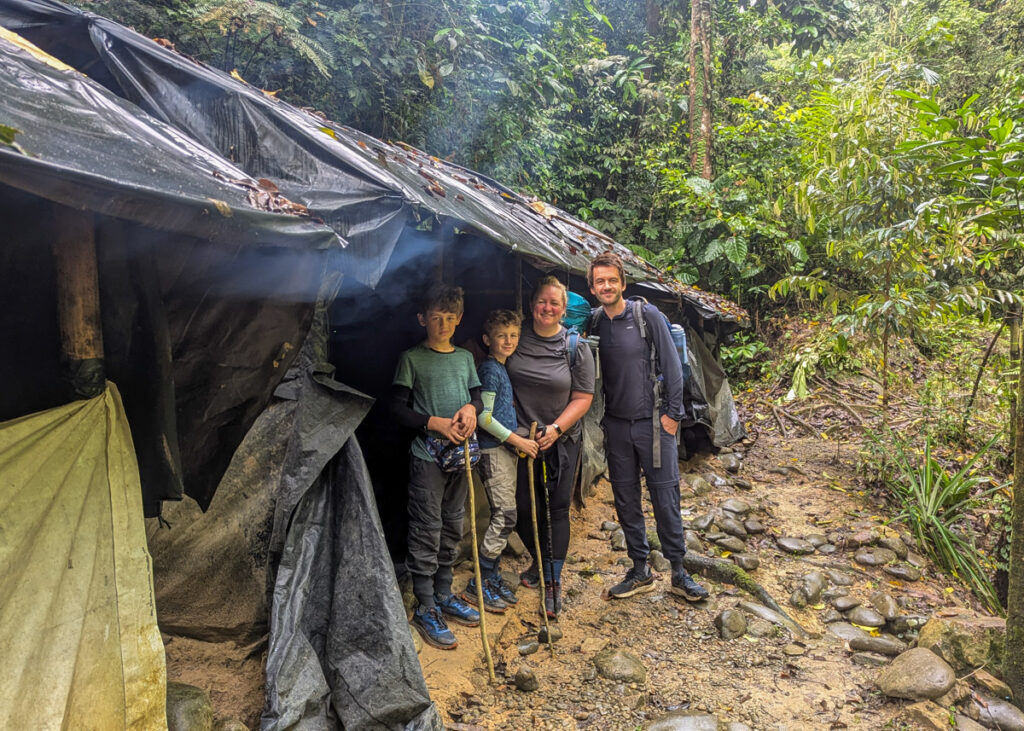
Day 5: Travel to Berastagi
Where we stayed: Berastagi Mountain View Homestay & Pizzeria. A little out of town, but with absolutely incredible views across the lush farmland and beyond to the surrounding volcanoes. We had two separate rooms on the top floor with balcony and seating area to ourselves. It’s the perfect set up for families.
It’s a 4 hour drive to Berastagi and once again we arranged a private transfer through Andrea at Green Hill (IDR 800,000). Be prepared, the road up to Berastagi is incredibly winding, so if you’re prone to motion sickness, consider taking precautions.
Along the way, ask your driver to stop at Mount Sinabung. This is an active volcano that last erupted in July 2021. While it was once a popular hiking destination, it remains closed to visitors due to ongoing volcanic activity. However, you can still admire it from the roadside, where the scorched earth from the recent eruptions is clearly visible.
We absolutely loved our stay at Berastagi Mountain View Homestay & Pizzeria. It was the perfect place to unwind from the long drive. We spent the late afternoon and evening playing cards, eating pizza, and soaking in the wonderful mountain views as the call to prayer from the nearby mosque drifted intermittently across the fields; a well-earned break before tomorrow’s adventure!



Day 6: Hike up Mount Sibayak
READ: Hiking Mount Sibayak
Where we stayed: Berastagi Mountain View Homestay & Pizzeria
The trek to the crater of Mount Sibayak, a dormant but geologically active volcano, ranks among our favourite family hikes (if you’ve been following us for a while, you’ll know that’s saying something).
While most hikers aim for sunrise, we recommend a 9am start if you’re hiking with kids. This allows for a more relaxed departure and avoids the early morning crowds. Plus, the trail can be tricky underfoot, so having daylight makes navigation much easier.
No guide is needed, but you’ll need to register at a hut along the way (IDR 20,000 per person).



Arrange for a minivan to take you to this start point. Public minivans only go part-way, adding an extra hour of hiking. Also, be sure to pack layers as it gets chilly at the top, so a jumper or jacket is a good idea.
From the main start point, it’s a 3.5km uphill trek to the crater. About 1 km in, you’ll reach the registration hut. Beyond this, the path can be muddy in places, with some steep sections, but overall, it’s a gradual ascent. You’ll know you’re nearing the crater when you smell the sulphur!
The view at the crater is incredible. Neon-yellow fumaroles hiss and steam around you, creating a dramatic, almost otherworldly landscape. You can also walk down to the crater lake, where it’s become a bit of a tradition to write your name using rocks in the water.
Allow 4 hours to do the trek up and down. We suggest you read our guide to hiking Mount Sibayak for more information on what to expect on this adventure.
After the hike, you might want to soak in the hot springs, located 5 km from the start of the trail. You can walk there or catch a minivan, which are usually waiting for tourists. However, be aware that the hot springs are communal and not the cleanest (there’s no filtration system and no-one showers before getting in).
Once back at your accommodation, pre-book your transfer to Medan for the following day (IDR 670,000).
Day 7: Travel to Medan
Where we stayed: Travellers Suites Serviced Apartments. A huge apartment with two separate bedrooms, lounge, dining area and kitchen. You can order in takeaways via the Grab app if you want to treat yourselves. There is a swimming pool, but it’s small and not the most inviting.
After breakfast on your balcony, taking in the final views of the surrounding volcanoes, travel back to Medan via private car. It’s a very windy road back down from Berastagi. Allow 3 hours to get into central Medan, depending on traffic.
We were able to check into Travellers Suites Serviced Apartments at noon and ordered in lunch via the Grab app.
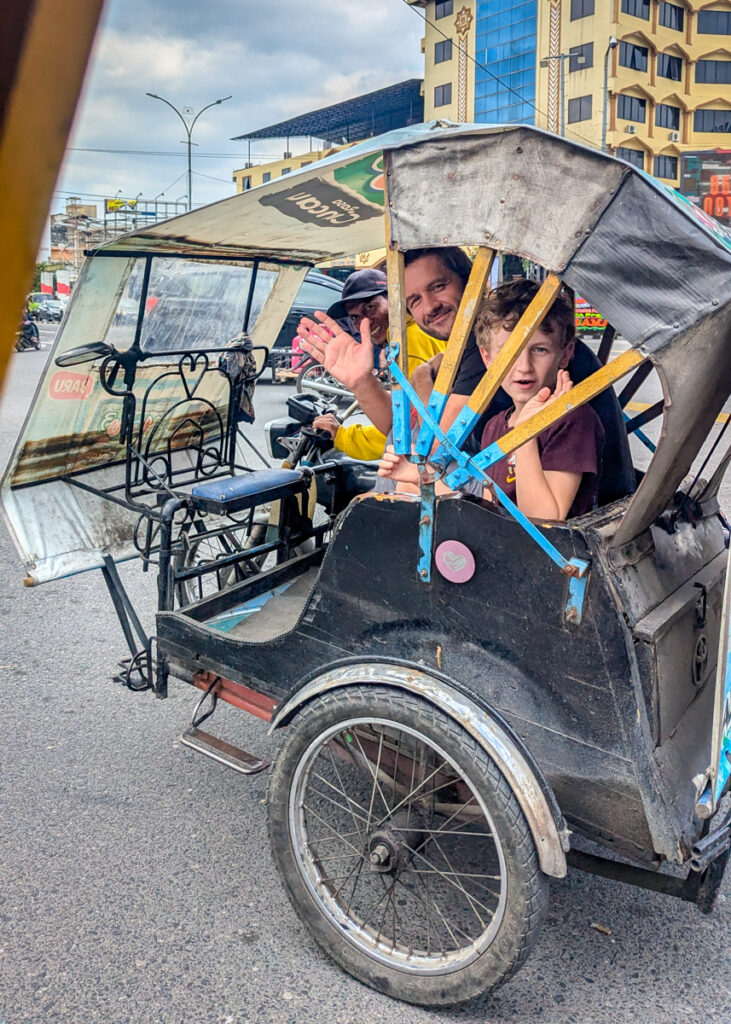


With half a day spare, you have time to explore Medan. While it might not be the most inspiring city, it does have a few gems, including Maimum Palace (a 19th century royal palace, IDR 10,000 per person cash), Great Mosque of Medan (Masjid Raya), Tjong A Fie Mansion (a restored historical mansion, IDR 35,000 per person), and some interesting Dutch colonial architecture. The kids will love zipping around the city in a motorbike trishaws (you will see these hanging around the tourist sites), otherwise order a taxi via the Grab app.
End the day with pizzas and drinks at District 10, which is across the road from Travellers Suites Serviced Apartments.
If you are heading to the airport in the morning, pre-book your taxi using the Grab app for peace of mind.
If you have more time in Sumatra
Lake Toba, the largest volcanic crater lake in the world, is often featured on Sumatra itineraries and in all honesty, we’re gutted we missed it out. However, you really need a ten day Sumatra trip to be able to fit it in. We really don’t recommend squeezing it into a one-week itinerary.
Samosir Island, in the centre of the lake, is where more visitors stay at Lake Toba. The town of Tuk Tuk is the main hub, lined with lakefront hotels and guesthouses. Getting there takes some time. Allow at least three hours to reach Parapat, from where ferries depart for Samosir Island.

We recommend at least 3 nights (2 full days) to make the journey to Samosir Island worthwhile. It’s then a 4 hour drive from Parapat back to Medan.
While at Lake Toba, you can visit Batak villages and museums, take a day trip to visit Sipiso Piso Waterfall, hike up Pusuk Buhit, or just enjoy some chilled beach time and swimming at Parbaba Beach (there are lots of watersports on offer here) or Pantai Batuhoda (a sandy beach to the north of the island).
I’m sure we’ll be back to Sumatra. As we live in Penang, it’s a very easy hop over on a flight. I’ve already scoped out Reggae Guest House for our next trip. Their family suite with two double beds and a private balcony overlooking the lake looks just perfect.
Final thoughts on visiting Sumatra with kids
For so many years, Indonesia was the major piece missing from our Southeast Asian jigsaw, and we were all incredibly excited about visiting the country for the first time. In this large, spread-out and diverse nation, Sumatra is undoubtedly different from some of the more famous tourist destinations to the east (e.g. Jakarta, Lombok or Bali).
If like us, you only have a week to spare, visiting Sumatra with kids can still pack in a huge number of epic travelling experiences, with the overnight jungle trek and hike to the volcanic crater creating memories we’ll cherish for ever.
With slightly more time, it would have been great to see Lake Toba as well but, on the positive side, it gives us a great excuse to visit this magical island again in the future.
Sumatra stories on Instagram
If you would like to get more of a visual idea of what to expect travelling Sumatra with kids, you can head over to our Instagram where in the Highlights section we have saved stories from our Sumatra travels. Click here to view.
You may also like to read:
2D/1N Bukit Lawang family jungle trek with Green Hill
Hiking Mount Sibayak: climb to a volcanic crater in Berastagi
Malaysia with kids travel guide

